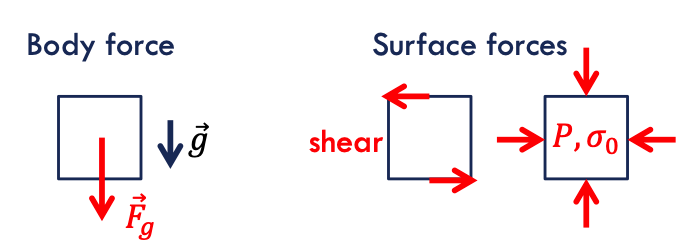Fluid transport KNW 2
1/13
There's no tags or description
Looks like no tags are added yet.
Name | Mastery | Learn | Test | Matching | Spaced |
|---|
No study sessions yet.
14 Terms
force types in fluid mech
body forces → associated with the presence of external fields acting equally on all fluid elements
surface forces → acting on the surface of the control volume

reference systems
Lagrange → development of a fluid package of constant mass
Euler → mass flux through fixed volume
require local derivatives ads the property changes w/ time
navier stokes eq → consider the velocity field that changes as function of time and space
fluid types
inviscid = ideal fluids w/ no internal friction
viscous = fluids w/ friction (resistance to shear)
newtonian → µ = const
non-newtonian → shear rate dependant t viscosity
equations of motion
Euler equation: for ideal fluids considering gravity and normal stresses (pressure)
Navier-Stokes equation: considers in addition viscous forces for Newtonian fluids.
Stokes equation: derived from NS for stationary (steady state) flow.
hooks law
The force that is needed to extend or compress a spring is linear to the distance of elongation or compressions
stress types
static → amount of deformation
𝜎 = 𝑐 𝜀
𝜎 = 𝑁/𝑚2
𝜀 = 1
𝑐 = stiffness tensor
dynamic → rate of deformation
𝜏 = 𝜇 𝜀
𝜏 = 𝑁/𝑚2
𝜀 = 1/𝑠
viscous stress force types
Viscous forces with linear or volumetric dilation of fluid elements.
Apparent viscous forces associated with dissipation during 1. → related to bulk viscosity of a compressible fluid.
Surface forces associated with thermodynamic pressure
normal stress application cond
Static conditions → thermodynamic pressure → 𝜎𝑥 = 𝜎𝑦 = 𝜎𝑧
(arithmetic average)
Dynamic conditions → mechanical pressure → 𝝈𝒙 = 𝒑 + 𝝉𝒙𝒙
normal stress importance
they can occur under static conditions – isotropic (thermodynamic) pressure
They can occur under dynamic conditions:
In a deviatoric but purely non-deformable way (the principal shape is conserved) if the stresses are isotropic → bulk or volumetric viscosity
In a purely deformable way if the stresses are purely anisotropic → shear viscosity 𝜇.
heat capacity, C
the heat 𝑄 that is required to change the temperature by ∆𝑇
thermal diffusivity
measures the ability of a material to conduct thermal energy relative to its ability to store thermal energy
newtons 1st law of motion
an object either remains at rest or continues to move at a constant velocity 𝑢, unless acted upon by a force (constant momentum).
newtons 2nd law of motion
that rate of change of momentum of an object (body) is proportional to the net force applied to the object – the change is in direction of the applied force.
peclet number
dimensionless number describing the relative importance of advective to diffusive transport